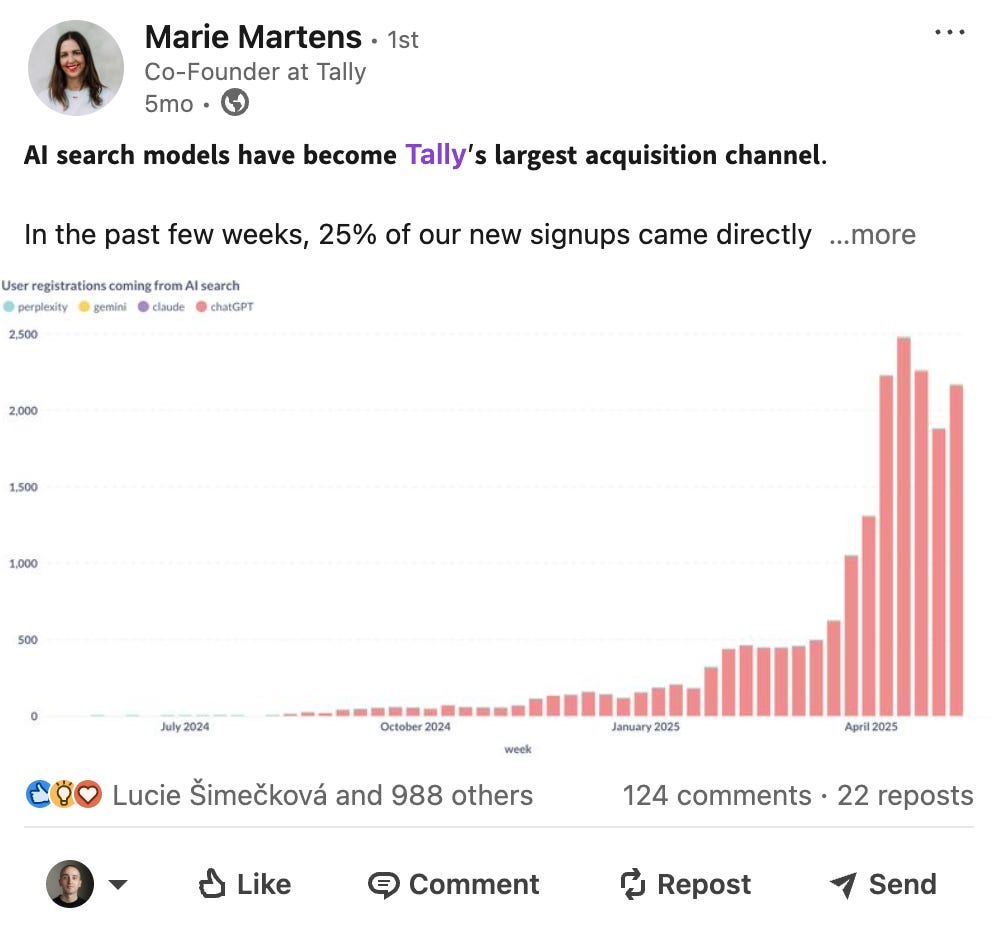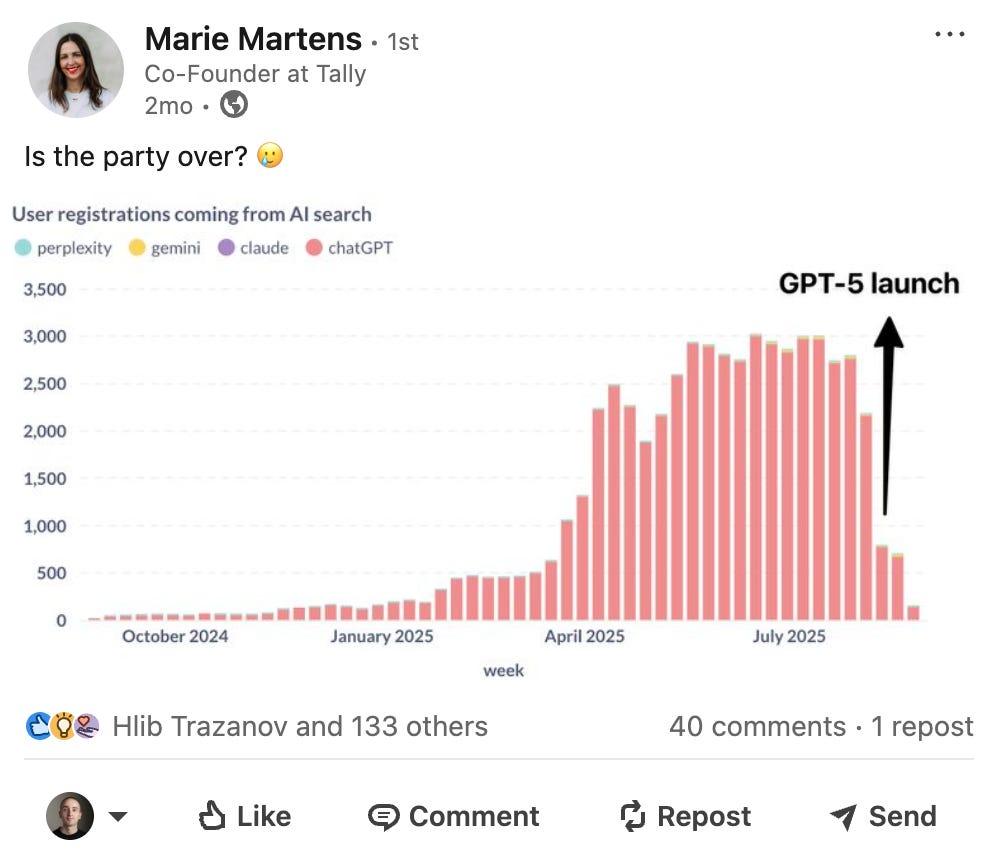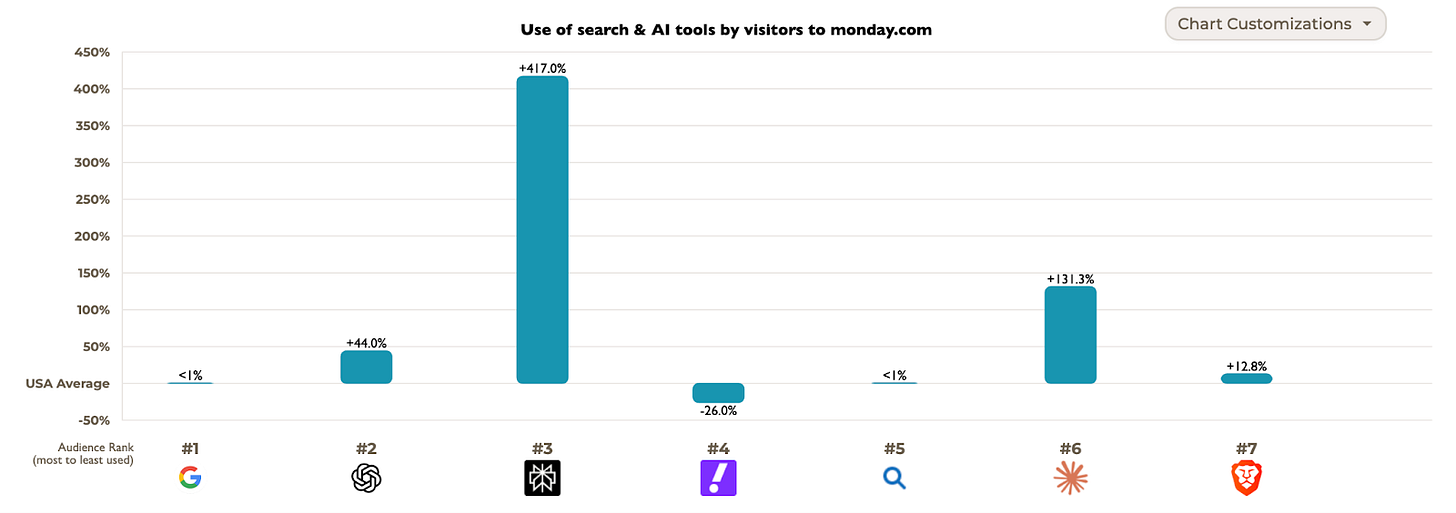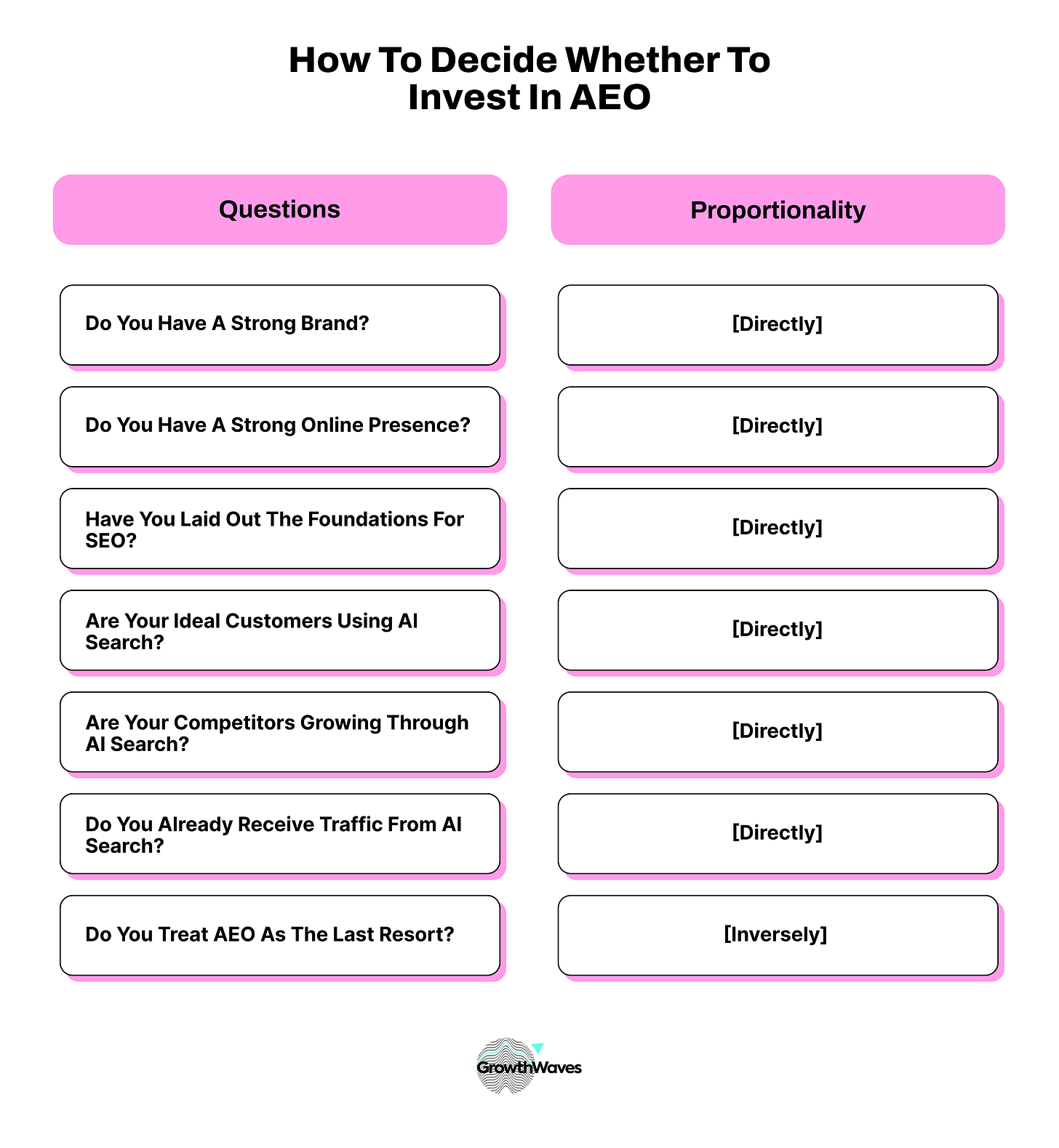Don’t invest in AEO
Not every company needs AEO—here’s how to tell if yours does
👋 Hey, I’m George Chasiotis. Welcome to GrowthWaves, your weekly dose of B2B growth insights—featuring powerful case studies, emerging trends, and unconventional strategies you won’t find anywhere else.
This note is brought to you by Minuttia.
AI search is changing the game.
Most brands are still optimizing just for Google.
Smart ones are also optimizing for ChatGPT, Gemini, Claude—and whatever comes next.
That’s what we do at Minuttia.
We help B2B companies dominate search—not just traditional SEO, but AI-driven discovery too.
Here’s how we do it:
Develop AI + Google search strategies
Create high-quality human and AI content
Amplify visibility through Digital PR
Continuously improve with agent analytics & reporting93% of our clients stick around.
And >63% of our revenue comes from repeat business. Not by accident.
If you want to win on AI search before it’s table stakes, talk to us.
We’re already helping 50+ B2B SaaS companies. You could be next.
I know the title of the note is a bit provocative.
Trust me, it’s not just to get the click.
(Though I obviously do want that.)
This note explains why—and when—you shouldn’t invest in AEO.
Despite what almost everyone is telling you on LinkedIn.
So, with much-needed sobriety, let’s dig in.
Author’s Note: For simplicity’s sake, I’ll use the term AEO (Answer Engine Optimization) interchangeably with GEO (Generative Engine Optimization) and LLMO (Large Language Model Optimization). This note isn’t about terminology—it’s about sharing my opinion on the topic.
The hype
First, let’s unpack the hype around AEO.
As you can see in the timeline below, ChatGPT launched in November 2022.
Less than two years later, ChatGPT introduced SearchGPT, signaling clearly where things were heading for the search community.
In December 2022, Perplexity launched.
Although it didn’t grow as fast as ChatGPT, it introduced users to a chat-like search experience.
Another key milestone: May 2024, when Google launched AI Overviews.
Essentially, the SEO community had to grapple with…
Intense volatility in Google Search
The possibility of AI Overviews being released to Google Search
Several newcomers introducing a new way of searching
… for a bit less than two years—at least until ChatGPT, Perplexity, and other AI search engines started sending traffic to websites.
During these two years, there was—and still is—a lot of panic in the industry.
Amid all this, a quick personal story is telling:
I was at a speaker’s dinner for an event where I was presenting.
Next to me sat an SEO veteran—one of those guys who’s been around since before Google even launched. (I’m exaggerating, but you get the point.)
At some point, he told me:
“It’s the first time in my career I’m thinking about doing something else.”
“Message received,” my inner voice said.
During these two years, the SEO industry really needed a “shelter” as things started getting really hairy, really quickly.
AEO was exactly that.
Now, I know what you’re thinking:
“But, George, wait a minute, there’s an overlap between SEO and AEO.”
There’s overlap, sure, but SEO and AEO are different channels.
AEO is expanding search, not replacing it.
In that context, there’s ~90% overlap between SEO and AEO.
But that 10% that doesn’t overlap makes all the difference.
And, of course, the activity of search is for the most part the same, even though the specifics of it (e.g., keywords vs prompts) are somewhat different.
Besides all the above, though, a new category of software came to add to the hype and “adoption” of AEO by the SEO industry.
Tools like Profound, AirOps, Peec AI, and Rankbee (full disclaimer: I’m an investor), among others, launched and entered an arms race to build the platform for AEO.
However, the incumbents in the category have entered the race with the addition of AI visibility tracking features to their suites.
I’m talking about tools like SEMrush, Ahrefs, and Surfer.
But this category is already showing signs of strain.

And even though I generally stay away from predictions, you’ll allow me to say that I see signs of a tiny bubble in this category.
To put it another way, many of the tools that raise money and enter the AI visibility tracking (or however you want to call it) race aren’t going to make it.
Or, at least they’re going to live up to their investors’ expectations.
The last element that has formed this hype is content like this…

And, yes, posts like this will make your CEO go like this to your CMO:
CEO: “Hey, can you check this? These folks from Tally are killing with this AEO thing.”
CMO: “Ohh, sure. Thanks for sending it over.”
CEO: “We need to make it a priority for next quarter to improve our visibility there.”
CMO: “Thanks, I’m looking into it with the agency.”
CEO: “Let me know if you need extra resources. This is a top priority for us for next quarter.”
CMO: Taking a deep breath…
So, essentially, we have three elements forming the hype around AI search:
The question is:
Should you fall for it?
Short answer: it’s not that simple.
Here’s what I mean.
First of all, there are already many voices raising the fact that AI search referral traffic may have reached its peak.
An example below:

And another one focusing specifically on the number of brands being mentioned and the average brand visibility, among other things:

I think we should take all these things with a grain of salt.
We’re still early in the adoption cycle of AI search, and many unknowns remain.
That aside, though, let’s be pragmatic for a minute.
And let’s ask an important question:
“Are my potential customers on AI search?”
The following chart (via SparkToro) shows the use of AI search and discovery tools such as Perplexity and ChatGPT by people visiting the website monday.com relative to average use in the US:
It’s clear that Monday’s visitors—many of them likely customers—use AI search tools like ChatGPT, Perplexity, and Claude more than the average U.S. user.
That’s somewhat expected, since people using or searching for a project management solution such as Monday are more likely to be tech-savvy and use AI search engines as part of their online behavior.
So, in that case, Monday should invest in AI search visibility.
But what if they’re not? Or if you don’t have enough data to support investing in AEO?
As a first step, you should talk to your customers.
I know it sounds detrimental.
But I had a call with a founder and serial entrepreneur this week.
He told me that, at a pivotal moment for his SaaS startup, he personally interviewed 300 users.
Not 3, not 30, 300.
I guess there’s no wonder why they’re growing like crazy and gearing up towards raising their B Round.
Another thing you need to look into when making a decision around AEO is whether you receive traffic from it already.
That’s a small signal the channel is working—at least passively.
Here’s an example for my AEO agency, Minuttia:
As you can see, ChatGPT and Gemini are both drivers of referral traffic for our website, even though they don’t perform as well in terms of events.
Still, this single data point is reason enough to dig deeper and improve visibility.
Here’s a simple framework to help you decide whether to invest in AEO.
All answers are a simple Yes or No.
The first six questions each count as +1 if answered “Yes.” The last one is a reverse signal and counts as -1.
Let’s wrap this up.
Final thoughts
If there’s one takeaway from this note, it’s this: don’t do things just for the hype.
Only invest in AEO—or anything else—if it makes sense for your specific case.
To drive this home:
The buzz around AEO is real.
But so is the need to make sure it actually applies to your case.
Don’t buy the hype. Invest responsibly.
Thank you for reading today’s note, and see you again next week.







